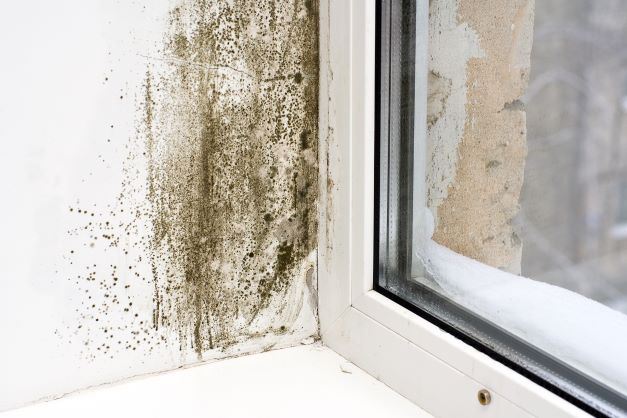Mould and dampness

Mould growing near a window
Mould has been recognised as a key indoor biological pollutant that may cause adverse health effects to the building’s occupants.
Mould can also result in unpleasant odours and damage to building materials, contents and structures that may lead to expensive maintenance or management costs.
Mould is a common term for all species of microscopic fungi that grow in the form of multicellular filaments (hyphae). It can grow on most building materials including:
- ceilings
- carpets
- glass and wood or
- in heating, ventilation and air conditioning (HVAC) systems.
While nutrients, oxygen, moisture and appropriate temperature are all essential for mould growth, moisture is the key component.
Moisture control is therefore the primary way to limit mould growth. Excess moisture sources can be generated from factors such as inappropriate building design and construction, poor building maintenance and insufficient or inadequate ventilation. Indoor moisture can be affected by occupants’ behaviour and moisture generating activities.
Occasional events such as floods and storms can also lead to water damage indoors with the subsequent development of mould contamination if not adequately managed. Excess moisture not only increases the risk of mould growth but can also promote the proliferation of other indoor biological pollutants, including bacteria and allergens such as house dust mite, as well as increase chemical emissions from building materials. All of these can adversely affect human health and therefore moisture, irrespective of the presence of mould, needs to be minimised in indoor spaces.
Guidelines for managing mould and dampness related to public health risks in buildings
Ideally the prevention of dampness and potential mould problems should be considered at the building design and construction stages:
Mould and dampness assessment
- The early identification of mould problems, as well as the extent of the problem is important for determining the required remediation.
- The source of the mould and/or dampness problem needs to be identified so that it can be rectified.
- Visual inspection using indicators such as visible mould, visible water damage, excess condensation, standing water and mouldy odour is recommended. This should be part of regular building inspections or conducted in response to suspected contamination.
- Investigation and monitoring of the moisture level of the building structure, materials or the indoor air may be required to help determine the underlying source of the problem.
- Surface or air sampling of mould spores is not recommended for establishing the level of health risk. However, sampling may assist in determining the extent of mould contamination ahead of defining the Scope of Works required for effective remediation, especially where hidden mould is suspected.
- Always consider the potential exposure to mould and the protection of people who conduct mould inspection.
Identification of the mould and water damage
Mould or dampness is identified or confirmed by the presence of any of the following indicators, alone or in combination:
- visible mould growth
- visible signs of dampness
- perceived mouldy/earthy odour
- presence of condensation or high humidity
- presence of standing water
- previous documented building history of water damage or mould growth
- moisture readings within the building materials or major furniture items elevated above ‘environmentally normal’ for the building at time of inspection.
- if occupants report symptoms consistent with mould or dampness this may also trigger a concern requiring further investigation. However, symptoms are often diverse and nonspecific and can have multiple causes. Therefore, symptoms by themselves are not necessarily a good indicator
Further resources
Last reviewed: 28-07-2022
Produced by
Environmental Health Directorate